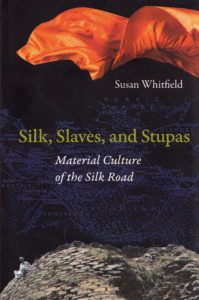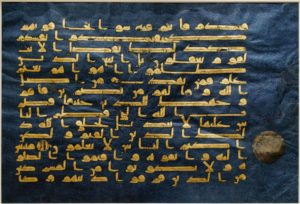Susan Whitfield. Silk, Slaves, and Stupas: Material Culture of the Silk Road. Berkeley: University of California Press, 2018.
There are many ways of writing about the Silk Road. Most scholars choose to frame their narratives through the familiar prisms of politics, religion, and geography. In her new book, Susan Whitfield adopts a novel lens: objects. Over the course of ten chapters, Whitfield analyzes ten separate objects, using each one to highlight major themes of cultural, economic, religious, and political exchange across Eurasia. With the exception of the final chapter, which examines the commodity of slaves, each object is accompanied by a striking color image and a detailed map of the locations and trade routes associated with it. The high production values of these supplementary visual aids are one of the great strengths of the book, allowing readers to flip back and forth between the two while digesting Whitfield’s narrative.
 The objects featured in each chapter are presented in rough chronological order based on their estimated date of production or use. Thus Chapter 1 begins with a pair of steppe earrings excavated from the Xigoupan tombs in the Ordos region of China. Having been dated to the second century BCE, these earrings provide Whitfield with a convenient platform to discuss the Xiongnu confederation, relations and cultural exchange between the Xiongnu and the Han dynasty, the jade industry, and the position of women in steppe cultures. In Chapter 2, a Hellenistic glass bowl that somehow ended up in a tomb in southern China allows Whitfield to discuss the history of glass production, the allure of glass compared to other nonorganic human technologies (i.e., pottery and metalworking), and maritime trade routes between the Levant and East Asia. Chapters on a Bactrian ewer, Buddhist stupa, the “Blue Qur’an,” a Khotanese plaque, and Byzantine silk follow, among others.
The objects featured in each chapter are presented in rough chronological order based on their estimated date of production or use. Thus Chapter 1 begins with a pair of steppe earrings excavated from the Xigoupan tombs in the Ordos region of China. Having been dated to the second century BCE, these earrings provide Whitfield with a convenient platform to discuss the Xiongnu confederation, relations and cultural exchange between the Xiongnu and the Han dynasty, the jade industry, and the position of women in steppe cultures. In Chapter 2, a Hellenistic glass bowl that somehow ended up in a tomb in southern China allows Whitfield to discuss the history of glass production, the allure of glass compared to other nonorganic human technologies (i.e., pottery and metalworking), and maritime trade routes between the Levant and East Asia. Chapters on a Bactrian ewer, Buddhist stupa, the “Blue Qur’an,” a Khotanese plaque, and Byzantine silk follow, among others.
One of the virtues of Whitfield’s approach is that she is able to range far and wide among the various peoples, cultures, and polities of Eurasia and Africa. Though half of her ten chapters deal with objects that were excavated within the present-day boundaries of China—a reflection of the longstanding Sinocentric bias in the field of Silk Road studies—Whitfield goes to great lengths to contextualize these finds within broader Eurasian networks of exchange far outside of China. And with the five remaining chapters not intimately associated with China, Whitfield takes the reader well beyond the usual geographical and cultural parameters of most Silk Road studies. Of particular note in this regard are Chapter 3, which expounds upon the discovery of a hundred gold Kushan coins in the Axum kingdom of present-day Ethiopia, and Chapter 7, which highlights a single folio from the so-called Blue Qur’an as a springboard to discuss the history of book production, the complex dying process, the use of “golden” ink, and, of course, the integral role of Islam, which often receives short shrift in treatments of the Silk Road.
Another novel feature of the book is Whitfield’s conclusion of every chapter with an intriguing “afterlife” of the object under scrutiny. In these sections, Whitfield charts the life history of the object as it changed hands over the centuries and eventually entered the worlds of museums and collectors. Most of these people knew little about the original production, movement, and function of the object, and instead proceeded to give it new purpose and meaning in new contexts. For me, this was one of the most intriguing parts of each chapter, and I often found myself wishing that Whitfield had devoted even more space to these afterlives. They range in length from a mere paragraph (the Hellenistic glass bowl of Chapter 2) to seven full pages (a Chinese almanac from Dunhuang highlighted in Chapter 9), with most in the range of two to three pages. The afterlife of the folio from the “Blue Qur’an” is particularly fascinating, as Whitfield deftly shows how individual pages transformed over time from private devotional texts to public emblems of the Islamic cultural world, more for gawking than for reading.

A leaf from the “Blue Qur’an,” one of several unorthodox objects that Whitfield includes within her survey of Silk Road material culture. Metropolitan Museum of Art, New York. Photo by Marie-Lan Nguyen, Wikimedia Commons.
As a brief aside, I was surprised to find her narrative of the afterlife of the steppe earrings in Chapter 1 resonating with me on a personal level. After surveying the modern history of these earrings being lent by Chinese museums for international exhibitions abroad, Whitfield makes the astute observation that they have never been displayed as part of an exhibit focused explicitly on the Xiongnu, instead being advertised as part of better known—yet grossly anachronistic and geographically misleading—steppe confederations such as the Mongols or Scythians, or more recently as part of “Silk Road” exhibitions. I can still recall clearly how, as a fifteen-year-old high school student back in the summer of 1995, my mother took me to the Royal British Columbia Museum in Victoria, Canada to see an “Empires of the Steppe” exhibit replete with allusions to “Genghis Khan” and the Mongols. The earrings, along with many other artifacts dating to the Xiongnu era and that of other nomadic polities in East and Inner Asia, were undoubtedly described, as Whitfield herself notes, with great accuracy in the fine print on each accompanying placard. These placards, however, made far less of an impression on me than did the posters and brochures surrounding the event. Before reading Whitfield’s book, I spent the last twenty-three years believing that I had visited a “Genghis Khan” exhibit, when in fact I had seen an exhibit filled mostly with Xiongnu, Khitan, and Jurchen artifacts that predated the Mongols by hundreds and in some cases over a thousand years.
In spite of these many virtues to the book, most readers will likely be surprised to find how little they learn about the original function and identities of the actual objects featured in the color plates. The ten objects featured in this book serve chiefly as convenient entry points into a discussion of closely related themes, events, and peoples surrounding the objects. Whitfield is also not afraid to draw attention to just how little we know about the histories of individual objects or the identities of those who created and used them. Her conclusion regarding the steppe earrings analyzed in Chapter 1 is typical in this regard:
What we can assume, given the earrings’ materials and their complexity, is that they were an indication of wealth and status. But apart from this, as with many archaeological artifacts, we are in a state of uncertainty. We cannot be certain where they were made or who made them, and whether they were made as a whole or in parts. We do not know whether they were made for trade, gift, or ritual and whether they were acquired by purchase, plunder, or some other means. Nor do we know whether the peoples of the Xigoupan burials saw these artifacts as part of their own culture or considered them somehow foreign. (30)
Despite her critique of the international packaging of Xiongnu artifacts in museum exhibitions, Whitfield is not even willing to slap the loose identity label of “Xiongnu” upon these earrings. In fact, after twenty-one pages of detailed discussion of steppe and sedentary interactions, dragon motifs, the ubiquity of belt plaques, and gender roles, the only firm conclusion she is willing to offer her readers is that these earrings were “an indication of wealth and status.”
Such candor is refreshing. But it can also be quite jarring for readers accustomed to Silk Road narratives that take refuge in more definite and familiar interpretive prisms, such as politics and religion. Anchoring one’s narrative in the history of the Kushan or Tang dynasties or the spread of Buddhism and Manichaeism may not represent a very novel approach, but readers of such narratives are likely to come away with a more definite grasp of key concepts, events, and peoples of the Silk Road, even if that grasp is to some degree deceptive in the end. This is ironic, for, more than any other analytical approach, Whitfield’s focus on material objects would appear on the surface to be rooted in more “tangible” interpretive prisms than any other. And yet rarely does the reader emerge from any chapter with the ability to say much of anything definite about the object on display beyond what might be stated in a simple two or three sentence caption. In that sense, we might characterize this book as offering its readers more a rich and eventful journey than a destination. Each chapter can stand more or less on its own, without reference to the other chapters. And there is no conclusion—after ten chapters and ten objects, the journey simply ends.
– Justin M. Jacobs, American University
